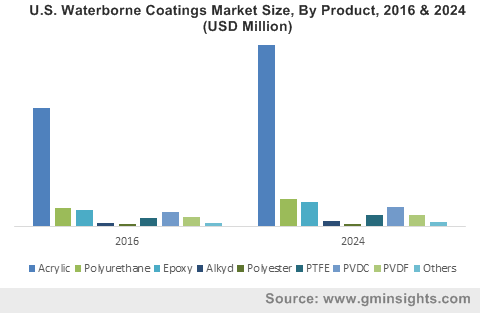Unveiling top two applications of Waterborne Coatings Market, Go-green notion to stimulate the industry growth
Publisher : Fractovia | Published Date : December 2017Request Sample
Axalta’s recent introduction of waterborne coatings in its Tufcote™ portfolio is remnant of the fact that waterborne coatings market is set to buzz with an influx of development activities. The firm has apparently expanded its industrial Tufcote product range with the launch of two waterborne acrylic products, namely Tufcote Hydro LV HG and Tufcote Hydro 2.1 HG. Through this launch, Axalta, one of the leading suppliers of sustainable and innovative solutions, is plausibly aiming to address the growing consumer demand for economical industrial products, taking a step further in strengthening its position in global waterborne coatings market. Contemplating the extensive sustainability trends across automotive, architectural, and the like industrial sectors, it goes without saying that the waterborne coatings product demand would be massive over the coming years, pertaining to its non-toxicity, low VOC content, eco-friendliness, and exceptional adhesive properties.
U.S. Waterborne Coatings Market Size, By Product, 2016 & 2024 (USD Million)

For the record, The VOC levels for Tufcote Hydro 2.1 HG and Tufcote Hydro LV HG are 2.1 lbs/gal and 0.8 lbs/gal respectively. The product range is claimed to grab a mass popularity across myriad end-use domains of waterborne coatings industry, Sustainability quotient seems to be the latest differentiating factor driving the global coatings space, the fundamental aspect that can be credited to waterborne coatings market’s extensive proliferation over the past few years. Market players are readily inclining toward diversifying their product portfolio to come up with solutions that are not only of improved functionality but also ensure environmental viability.
Below mentioned are two applications domains where the potential opportunities are claimed to be lucrative:
Architectural vertical| waterborne coatings industry analysis
The technological proliferation in waterborne coatings market has transformed architectural sector in more ways than one. Waterborne coatings, over the past few years, has become the standard technology for interior wall coatings, pertaining to its reduced VOC content. Perhaps marred by the fact that interior wall coating procures the largest chunk of the overall architectural coatings space, waterborne coatings market penetration in this particular business sphere is quite extensive. As per estimates, overall waterborne coatings industry share from architectural applications would record a massive valuation of over USD 85 billion by 2024, with a projected CAGR of 5.5% over 2017-2024. In tandem, stringent mandatory rollouts enforced by governmental entities such as EPA and European Union with regards to reduced VOC content in building infrastructure have apparently led to an increasing adoption of green technologies in architectural sector, in turn contributing to the overall waterborne coatings industry share.
Automotive OEM| Waterborne coatings industry analysis
Automotive sector is claimed to be a major growth source for waterborne coatings market- courtesy the exponentially increasing product demand for protecting the vehicles from UV rays, discoloration, harsh weather conditions, acid rain and the like. In this regard, a key waterborne technology that has been reigning the automotive space over the years is electrocoat, deployed universally as the first level of corrosion protection on light commercial vehicles. Statistics depict that renowned automakers have been slowly inclining toward waterborne coatings for color basecoats and other applications, barring Ford that still banks on solvent-borne coatings. However, experts claim, waterborne coatings market share from automotive OEM would witness a sluggish growth rate, pertaining to the fact that new automotive production lines are commissioned. Nonetheless, the growth prospects for waterborne coatings market in Europe and U.S. is forecast to be positively high, primarily backed by the emission control standardization set forth by the regional automotive emission control agencies.
Despite all the benefits of waterborne coatings, on the flip side, the product is claimed to possess low adhesive property over grimy, chalky, and peeling surfaces when compared to alkyds. This has somewhat constricted the application scope of waterborne coatings market in some of the sectors. In addition, it is prudent to note that the raw materials required for the development of waterborne coatings has a widespread application array, a situation which has led to the generation of a demand-supply gap owing to the spike in demand but lower raw material production. In consequence, it has been claimed that this scenario may have a slightly negative impact on the revenue scale of waterborne coatings market. However, renowned biggies are constantly investing in R&D activities to come with alternatives in a bid to bridge the gap. All in all, with the world circumnavigating on the path of go-green notion in every spectrum, the room for investments in waterborne industry is huge. Global Market Insights, Inc. forecasts the overall business space to record a mammoth valuation of over USD 95 billion by 2024.